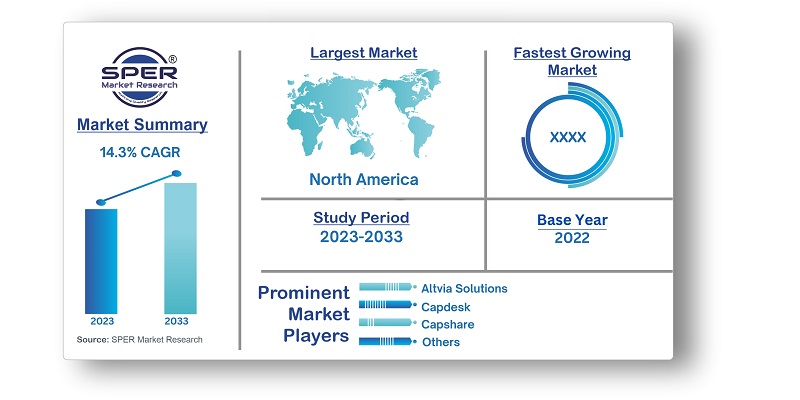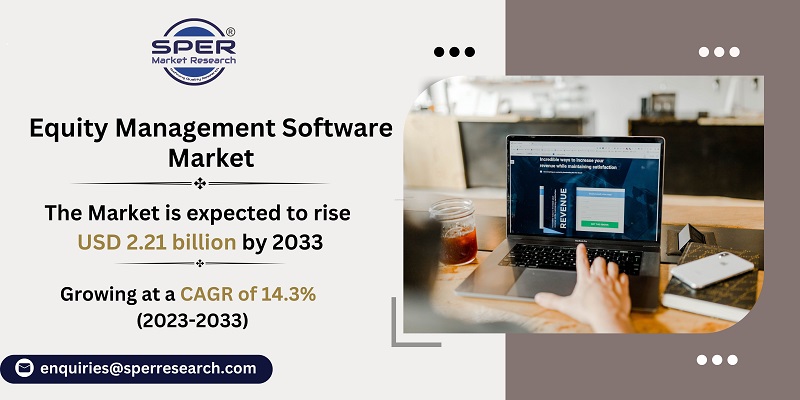
Equity Management Software Market Growth, Size, Trends, Demand, Revenue and Future Outlook
Equity Management Software Market Size- By Type, By Application, By Enterprise Size- Regional Outlook, Competitive Strategies and Segment Forecast to 2033
| Published: Oct-2023 | Report ID: IACT23172 | Pages: 1 - 224 | Formats*: |
| Category : Information & Communications Technology | |||
- November 2021: Preqin is the most comprehensive data source for the alternative equities business. Altvia, a private equity management software platform, worked with Preqin to integrate Preqin data with Altvia's CRM and investment management platform. As a result of the partnership, mutual clients can simply enhance their Altvia CRM with Preqin's investor and contact information for venture capital and private equity.
- January 2021: In order to increase the range of financial disclosure management and equity management services it offers, Insight Software announced that it has purchased Certent, Inc.


| Report Metric | Details |
| Market size available for years | 2019-2033 |
| Base year considered | 2022 |
| Forecast period | 2023-2033 |
| Segments covered | By Type, By Application, By Enterprise Size |
| Regions covered | North America, Asia-Pacific, Latin America, Middle East & Africa and Europe |
| Companies Covered | Altvia Solutions, Capdesk, Capshare, Carta, Certent, Eqvista, Euronext, Gust, Ledgy, Preqin Solutions, Others |
- Chief Financial Officers (CFOs)
- Accounting Professionals
- Consultants and Advisory Firms
- Corporate Secretaries
- Equity Plan Administrators
- Financial Service Providers
- Private Equity and Venture Capital Firms
- Shareholders and Investors
- Startups and Emerging Companies
- Others
| By Type: |
|
| By Application: |
|
| By Enterprise Size: |
|
- Global Equity Management Software Market Size (FY’2023-FY’2033)
- Overview of Global Equity Management Software Market
- Segmentation of Global Equity Management Software Market By Type (Basic, Senior, Standard)
- Segmentation of Global Equity Management Software Market By Application (Listed Company, Private Corporation, Start-ups, Others)
- Segmentation of Global Equity Management Software Market By Enterprise Size (Large Enterprises, Small and Medium-size Enterprises)
- Statistical Snap of Global Equity Management Software Market
- Expansion Analysis of Global Equity Management Software Market
- Problems and Obstacles in Global Equity Management Software Market
- Competitive Landscape in the Global Equity Management Software Market
- Impact of COVID-19 and Demonetization on Global Equity Management Software Market
- Details on Current Investment in Global Equity Management Software Market
- Competitive Analysis of Global Equity Management Software Market
- Prominent Players in the Global Equity Management Software Market
- SWOT Analysis of Global Equity Management Software Market
- Global Equity Management Software Market Future Outlook and Projections (FY’2023-FY’2033)
- Recommendations from Analyst
1.1. Scope of the report1.2. Market segment analysis
2.1. Research data source2.1.1. Secondary Data2.1.2. Primary Data2.1.3. SPER’s internal database2.1.4. Premium insight from KOL’s2.2. Market size estimation2.2.1. Top-down and Bottom-up approach2.3. Data triangulation
4.1. Driver, Restraint, Opportunity and Challenges analysis4.1.1. Drivers4.1.2. Restraints4.1.3. Opportunities4.1.4. Challenges4.2. COVID-19 Impacts of the Global Equity Management Software Market
5.1. SWOT Analysis5.1.1. Strengths5.1.2. Weaknesses5.1.3. Opportunities5.1.4. Threats5.2. PESTEL Analysis5.2.1. Political Landscape5.2.2. Economic Landscape5.2.3. Social Landscape5.2.4. Technological Landscape5.2.5. Environmental Landscape5.2.6. Legal Landscape5.3. PORTER’s Five Forces5.3.1. Bargaining power of suppliers5.3.2. Bargaining power of buyers5.3.3. Threat of Substitute5.3.4. Threat of new entrant5.3.5. Competitive rivalry5.4. Heat Map Analysis
6.1. Global Equity Management Software Market Manufacturing Base Distribution, Sales Area, Product Type6.2. Mergers & Acquisitions, Partnerships, Product Launch, and Collaboration in Global Equity Management Software Market
7.1. Global Equity Management Software Market Value Share and Forecast, By Type, 2023-20337.2. Basic ($Under 50/Month)7.3. Senior ($Above 100/Month)7.4. Standard ($50-100/Month)
8.1. Global Equity Management Software Market Value Share and Forecast, By Application, 2023-20338.2. Listed Company8.3. Private Corporation8.4. Start-ups8.5. Others
9.1. Global Equity Management Software Market Value Share and Forecast, By Enterprise Size, 2023-20339.2. Large Enterprises9.3. Small and Medium-size Enterprises
10.1. Global Equity Management Software Market Size and Market Share
11.1. Global Equity Management Software Market Size and Market Share By Type (2019-2026)11.2. Global Equity Management Software Market Size and Market Share By Type (2027-2033)
12.1. Global Equity Management Software Market Size and Market Share By Application (2019-2026)12.2. Global Equity Management Software Market Size and Market Share By Application (2027-2033)
13.1. Global Equity Management Software Market Size and Market Share By Product (2019-2026)13.2. Global Equity Management Software Market Size and Market Share By Product (2027-2033)
14.1. Global Equity Management Software Market Size and Market Share By Enterprise Size (2019-2026)14.2. Global Equity Management Software Market Size and Market Share By Enterprise Size (2027-2033)
15.1. Global Equity Management Software Market Size and Market Share By Region (2019-2026)15.2. Global Equity Management Software Market Size and Market Share By Region (2027-2033)15.3. Asia-Pacific15.3.1. Australia15.3.2. China15.3.3. India15.3.4. Japan15.3.5. South Korea15.3.6. Rest of Asia-Pacific15.4. Europe15.4.1. France15.4.2. Germany15.4.3. Italy15.4.4. Spain15.4.5. United Kingdom15.4.6. Rest of Europe15.5. Middle East and Africa15.5.1. Kingdom of Saudi Arabia15.5.2. United Arab Emirates15.5.3. Rest of Middle East & Africa15.6. North America15.6.1. Canada15.6.2. Mexico15.6.3. United States15.7. Latin America15.7.1. Argentina15.7.2. Brazil15.7.3. Rest of Latin America
16.1. Altvia Solutions16.1.1. Company details16.1.2. Financial outlook16.1.3. Product summary16.1.4. Recent developments16.2. Capdesk16.2.1. Company details16.2.2. Financial outlook16.2.3. Product summary16.2.4. Recent developments16.3. Capshare16.3.1. Company details16.3.2. Financial outlook16.3.3. Product summary16.3.4. Recent developments16.4. Carta16.4.1. Company details16.4.2. Financial outlook16.4.3. Product summary16.4.4. Recent developments16.5. Certent16.5.1. Company details16.5.2. Financial outlook16.5.3. Product summary16.5.4. Recent developments16.6. Eqvista16.6.1. Company details16.6.2. Financial outlook16.6.3. Product summary16.6.4. Recent developments16.7. Euronext16.7.1. Company details16.7.2. Financial outlook16.7.3. Product summary16.7.4. Recent developments16.8. Gust16.8.1. Company details16.8.2. Financial outlook16.8.3. Product summary16.8.4. Recent developments16.9. Ledgy16.9.1. Company details16.9.2. Financial outlook16.9.3. Product summary16.9.4. Recent developments16.10. Preqin Solutions16.10.1. Company details16.10.2. Financial outlook16.10.3. Product summary16.10.4. Recent developments16.11. Others
SPER Market Research’s methodology uses great emphasis on primary research to ensure that the market intelligence insights are up to date, reliable and accurate. Primary interviews are done with players involved in each phase of a supply chain to analyze the market forecasting. The secondary research method is used to help you fully understand how the future markets and the spending patterns look likes.
The report is based on in-depth qualitative and quantitative analysis of the Product Market. The quantitative analysis involves the application of various projection and sampling techniques. The qualitative analysis involves primary interviews, surveys, and vendor briefings. The data gathered as a result of these processes are validated through experts opinion. Our research methodology entails an ideal mixture of primary and secondary initiatives.



Frequently Asked Questions About This Report
PLACE AN ORDER
Year End Discount
Sample Report
Pre-Purchase Inquiry
NEED CUSTOMIZATION?
Request CustomizationCALL OR EMAIL US
100% Secure Payment






Related Reports
Our Global Clients
Our data-driven insights have influenced the strategy of 200+ reputed companies across the globe.




















